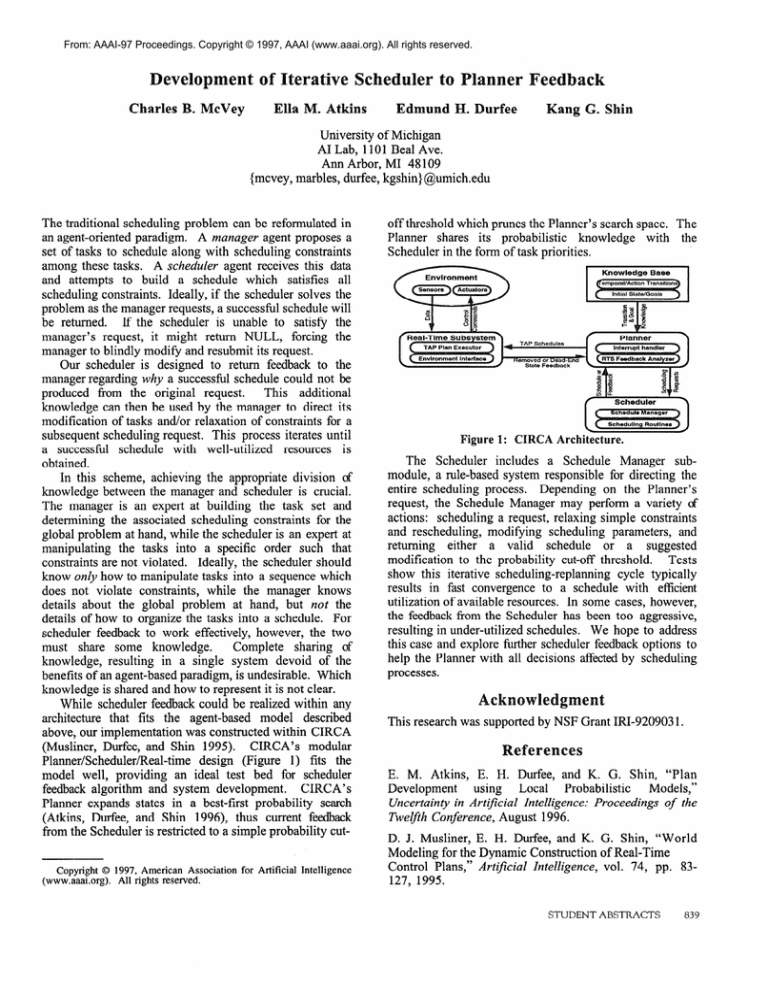
From: AAAI-97 Proceedings. Copyright © 1997, AAAI (www.aaai.org). All rights reserved.
Charles
B. McVey
Ella M. Atkins
University of Michigan
AI Lab, 110 1 Beal Ave.
Ann Arbor, MI 48 109
(mcvey, marbles, durfee, kgshin} @umich.edu
The traditional scheduling problem can be reformulated in
an agent-oriented paradigm.
A manager agent proposes a
set of tasks to schedule along with scheduling constraints
among these tasks. A scheduler agent receives this data
and attempts to build a schedule which satisfies all
scheduling constraints. Ideally, if the scheduler solves the
problem as the manager requests, a successful schedule will
be returned.
If the scheduler is unable to satisfy the
manager’s request, it might return NULL, forcing the
manager to blindly modify and resubmit its request.
Our scheduler is designed to return feedback to the
manager regarding why a successful schedule could not be
This additional
produced from the original request.
knowledge can then be used by the manager to direct its
modification of tasks and/or relaxation of constraints for a
subsequent scheduling request. This process iterates until
a successful schedule with well-utilized
resources is
obtained.
In this scheme, achieving the appropriate division of
knowledge between the manager and scheduler is crucial.
The manager is an expert at building
the task set and
determining the associated scheduling constraints for the
global problem at hand, while the scheduler is an expert at
manipulating
the tasks into a specific order such that
constraints are not violated.
Ideally, the scheduler should
know only how to manipulate tasks into a sequence which
does not violate constraints,
while the manager knows
details about the global problem at hand, but not the
details of how to organize the tasks into a schedule. For
scheduler feedback to work effectively, however, the two
Complete
sharing of
must share some knowledge.
knowledge, resulting in a single system devoid of the
benefits of an agent-based paradigm, is undesirable.
Which
knowledge is shared and how to represent it is not clear.
While scheduler feedback could be realized within any
architecture that fits the agent-based
model described
above, our implementation
was constructed within CIRCA
(Musliner, Durfee, and Shin 1995).
CIRCA’s modular
Planner/Scheduler/Real-time
design (Figure 1) fits the
model well, providing an ideal test bed for scheduler
feedback algorithm and system development.
CIRCA’s
Planner expands states in a best-first probability
search
(Atkins, Durfee, and Shin 1996), thus current feedback
from the Scheduler is restricted to a simple probability cutCopyright 0 1997, American Association for Artificial Intelligence
(www.aaai.org). All rights reserved.
off threshold which prunes the Planner’s search space. The
Planner
shares its probabilistic
knowledge
with the
Scheduler in the form of task priorities.
Knowledge
f
Base
Planner
\
Figure 1: CIRCA Architecture.
The Scheduler includes a Schedule Manager submodule, a rule-based system responsible for directing the
entire scheduling process.
Depending on the Planner’s
request, the Schedule Manager may perform a variety of
actions: scheduling a request, relaxing simple constraints
and rescheduling, modifying scheduling parameters, and
returning
either a valid
schedule
or a suggested
modification to the probability cut-off threshold.
Tests
show this iterative scheduling-replanning
cycle typically
results in fast convergence to a schedule with efficient
utilization of available resources. In some cases, however,
the feedback from the Scheduler has been too aggressive,
resulting in under-utilized schedules.
We hope to address
this case and explore further scheduler feedback options to
help the Planner with all decisions affected by scheduling
processes.
khOWk
t
This research was supported by NSF Grant N-920903
1.
E. M. Atkins, E. H. Durfee, and K. 6. Shin, “Plan
Development
using
Local
Probabilistic
Models,”
Uncertainty in Artificial Intelligence: Proceedings of the
Twelfth Conference, August 1996.
D. J. Musliner, E. H. Durfee, and K. 6. Shin, “World
Modeling for the Dynamic Construction of Real-Time
Control Plans,” Artificial Intelligence, vol. 74, pp. 83127, 1995.
STUDENT ABSTRACTS
839



